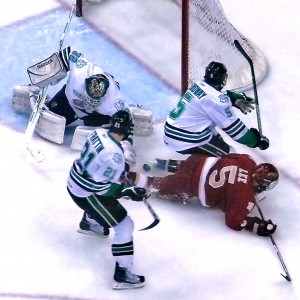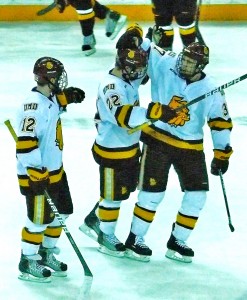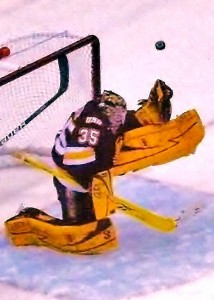UMD, UND charge into Frozen Four
By John Gilbert
With apologies to Hockey East and the ECAC, the 2011 NCAA Frozen Four has come down to a good-ol’ fashioned Western showdown, with the WCHA squaring off against the CCHA in what might be called the Xcel Xtravaganza. North Dakota and Minnesota-Duluth from the WCHA are paired against Michigan and Notre Dame, CCHA opponents that began their hockey programs as members of the WCHA, in the semifinals on Thursday, April 7 at Xcel Energy Center in Saint Paul.
North Dakota is top-seeded, although that has been no guarantee so far in the tournament. The Fighting Sioux, in fact, came through as the only regional top seed to make it to the Frozen Four in what has been the Year of the Upset so far. Michigan was second-seeded in the West Regional and barely survived against two other WCHA teams. UMD and Notre Dame were both third seeds, with UMD knocking out the top two ECAC teams to win the East Regional, while Notre Dame got past a pair of Hockey East foes to win the Northeast Region.
Ticket prices of $195 apiece haven’t stopped the demand, particularly from UMD, the only one of five Minnesota Division I programs to be playing in the homestate championships, and North Dakota, which has made it a tradition to travel by green-clad carloads to the Final Five at Xcel Center, which they won two weeks ago.
North Dakota is the clearcut favorite, coming in with titles in the WCHA regular season, the WCHA playoffs, and the Midwest Regional already headed for the trophy case. Clearly, the Fighting Sioux are at the peak of an exceptional season. But if this is the Year of the Upset, UMD is in good company, joining Notre Dame and Michigan as teams that won regionals where the top seeds were beaten.
The form chart held at the Midwest Regional at Green Bay, Wis., where North Dakota crushed RPI 6-0, and No. 2 seed Denver came from a 2-0 deficit to force a tie and then beat Western Michigan 3-2 in overtime. The anticipated rematch of the Final Five title game, which North Dakota won in overtime, saw the Fighting Sioux blitz Denver with a surprising 6-1 rout. Denver played well, but North Dakota was relentless, scoring at full strength, on the power play, shorthanded, empty netter — every imaginable way to push the score beyond the game’s level of competitiveness.
Elsewhere, the form chart meant nothing. UMD, as the third seed, surprised second-seeded Union 2-0 in the East Regional at Bridgeport, Conn., then the Bulldogs surprised the hockey world by stunning No. 1-overall seed Yale, racing to leads of 3-0 and 5-1 to beat those other Bulldogs 5-3. UMD goaltender Kenny Reiter was named most valuable player of the regional, after his acrobatic play stymied both ECAC foes.
UMD opens the Frozen Four in the 4 p.m. semifinal against Notre Dame, which upset Merrimack in the Northeast Regional at Manchester, N.H., while fourth-seeded New Hampshire upset top seeded Miami of Ohio. Notre Dame then beat UNH, no small achievement in Manchester, to reach the Frozen Four.
In the West Regional, defending NCAA champion Boston College was the overwhelming favorite, but was shocked and flat overrun by Colorado College in the first game at St. Louis, while Michigan got past Nebraska-Omaha in overtime on a controversial reversal by the officials, who changed their call of no-goal to a goal for the Wolverines, bringing new meaning to the term “sudden death.” The puck had bounced off a UNO defenseman and wound up under the leg pad of goaltender John Faulkner, whose leg wouind up on the goal line. Video replays showed Faulkner’s leg pad, but the goal line and the puck were both completely concealed, until the puck squirted out, and out of danger. Repeated views couldn’t change the fact that there was no evidence the puck had completely crossed the goal line, and certainly not enough evidence to change the original call. But after reviewing the videos for nearly 10 minutes, the officials declared that it was a goal, and Michigan won. The Wolverines also held off Colorado College 2-1 through a wave of penalties to claim the regional.
“Going to St. Louis, it was a foregone conclusion that Boston College had the best team, but Colorado College just spanked ’em. We got a lucky to win in overtime against Nebraska-Omaha, then we got by CC,” said Michigan coach Red Berenson, who is in his 27th season, and has remained as candid and humble person he was as a star player with the Wolverines and later in the NHL. “We had to kill seven penalties against CC, which had as good a power play as we’ve seen. We were fortunate to get out of the game alive.
“Three other No. 1 teams have gone down, and this is the last one standing — North Dakota. I don’t know if we can match North Dakota’s speed, or skill, and nobody has found a way to take that out of the game. They’ve got the edge in offensive skills and in special teams. We’ve got to play our game, and give it our best shot. We have an above-average team, led by the seniors. When we had our best team, we had seven 20-goal scorers; this team has no 20-goal scorers. But we haven’t been in any lopsided games. We’re probably the overwhelming underdog in this tournament, but we still have a chance.”

North Dakota's top-seeded Sioux are led by goalie Aaron Dell, top scorere Matt Frattin (21), defenseman Chay Genoway.
Under Hakstol, the Sioux have often started slowly, then built to a peak during the second half. This season, they started strong and never let up. “What we did well is keep ourselves focused on the job at hand and play a good team game. When you break down a game on video, there are a lot of points in a game when momentum can shift one way or another, if you get distracted or let a bad bounce get to you. We did a good job of worrying about the next play and trying to control what we can control. There are little areas that we hope we can improve on. We’re not going to make any drastic changes to our game, just do all the little things we’ve done.”
A forceful and balanced scoring offense is led by Matt Frattin, who won the league scoring title with a nine-point final weekend at Michigan Tech. Aaron Dell came in and became the top goaltender, and led all WCHA goalies in statistics. Even a string of injuries, including absences by key standouts like defenseman Chay Genoway and forwards Danny Kristo and Jason Gregoire, didn’t slow them. Genoway came back a few weeks before the end, Kristo returned from a case of serious frostbite in time to score in both Final Five victories, and Gregoire rejoined the lineup for the regiona. Hakstol, and the team, never wavered.
“Injuries have been a challenge for us,” said Hakstol. “When we went to Wisconsin, [Andrew] MacWilliam and [Derek] Forbort, who were paired on defense, both were dieagnosed with mono. It’s been the same way whenever anyone was out of the lineup — whichever 20 guys are available, they have the expectation to individually contribute and collectively succeed. This past weekend, we had everyone.”
As for facing Michigan, Hakstol said: “Our team will continue with the same mentality we’ve had since the beginning. We’ve shown up and worked hard, but we’ve been loose and had fun doing that. We felt we played well at Green Bay, but we have to continue to improve our game. We will prepare ourselves as we always do, for each and every opponent. This time of year, you need to be prepared to win games in different ways, different fashions, and have to have the mentality to get the job done however you have to do it.”
Someone asked if he had a preference for which opponent the Sioux might face if they beat Michigan. “I have a preference,” said Hakstol, “that at the end of the game, we’ve won the game.”
UMD, which split with North Dakota in two games at Grand Forks and lost a ceremonial game against the Sioux at the opening of Duluth’s Amsoil Arena, was ranked No. 1 in the country at midseason. The Bulldogs never lost two games in a row, and were never swept by any opponent all season, and have been led by the quick and clever first line of Jack Connolly centering Mike Connolly and Justin Fontaine, and an agile and rangy defense. Goaltending was shared by Kenny Reiter and Aaron Crandall, until, ironically, coach Scott Sandelin decided to go with Reiter down the stretch. Over the final four games, UMD had a chance to win the title, or finish second, or third, but dropped to fourth in the extremely close WCHA.
Getting it back together to sweep St. Cloud State in the playoffs sent the Bulldogs to the Final Five, where they were promptly dumped by Bemidji State in overtime. That loss was only UMD’s second in 14 overtime games this season, a record of 6-2-6. But that hardly sent UMD off to the East Regional flushed with confidence — theirs or their fans. But it was there that everything snapped into focus: Reiter became invincible, the defense became a shot-blocking gang, and the Connolly-Connolly-Fontaine line led the attack. Those three and Frattin remain the top four WCHA scorers in all games this season.

UMD's Jack Connolly (left), Mike Connolly (center), and Justin Fontaine are NCAA's top-scoring line.
Could the loss to Bemidji State have worked as an incentive? “It did sting,” said Sandelin. “I didn’t think we played very well, but give Bemidji a ton of credit. After that game, there was some disappointment. This group hasn’t lost a lot and they don’t like losing. It was interesting after we won the East Regional. Our guys were excited, but not overly excited. They captured the moment, and took it in stride. We advanced, but they were looking forward to not just getting to the Frozen Four, but having the chance to win a national championship.”
Notre Dame coach Jeff Jackson has built the Irish into a power, which is no surprise to those who remember him winning NCAA championships at Lake Superior State in 1992 and 1994. He took the Irish to the Frozen Four in Denver three years ago, but is quick to say he is pleasantly surprised by the coming together of this youthful group. “Were thrilled to death to be coming to St.Paul for the Frozen Four,” Jackson said. “It’s an unexpected treat for a young team.
“As a coach, this is one of more fun years I’ve had in a long time. We really paid a price, with 10 or 11 freshmen in the lineup every night, but last weekend, we responded both on Saturday and Sunday. All the signs show we’re growing up. Goaltender Mike Johnson played well. This group is one of closest teams I’ve ever coached, maybe the closest. It was interesting to watch them after we won the regional. They were all together, arm in arm, for our alma mater. That’s a first. The locker room was pretty entertaining, from my perspective. Because of the youth, there has been some consternation. I wasn’t sure what to expect going into the regional. We didn’t have a real long winning streak all year, but every time somebody is ready to count them out, they come back. I have to bite my lip and hold my breath sometimes, but they’re great kids, and our seniors have done a great job with them.”
Rising up to win the Northeastern Regional required the consistency that had been questionable. “Last weekend, the keys were that we paid more attention to detail, offensively and defensively,” Jackson added. “I thought we proved we could do things for the full 60 minutes, and not drift off. Both Merrimack and UNH scored late, but we played through it, I watched the growth of our team, and we have to carry that with us to the Frozen Four.
“I know Duluth plays a real high-tempo game. We try to do that too. We’ve shown the ability to play both ways, but in the CCHA, when you’re playing Michigan or Miami, you have to be able to play an up-tempo game.”
A year ago, Boston College won the national championship with a high-speed, up-tempo team. This year, all four teams in the Frozen Four prefer an up-tempo game. “That’s a good observation,” said Berenson. “Three of the four No. 1 seeds were upset, but maybe they weren’t upsets. Maybe we’re talking more parity. I like the direction college hockey is going. There’s a good tempo up and down, and the hockey is better hockey than what we’ve seen in previous years.”
Comments
Tell me what you're thinking...
and oh, if you want a pic to show with your comment, go get a gravatar!



 John Gilbert is a lifetime Minnesotan and career journalist, specializing in cars and sports during and since spending 30 years at the Minneapolis Tribune, now the Star Tribune. More recently, he has continued translating the high-tech world of autos and sharing his passionate insights as a freelance writer/photographer/broadcaster. A member of the prestigious North American Car and Truck of the Year jury since 1993. John can be heard Monday-Friday from 9-11am on 610 KDAL(www.kdal610.com) on the "John Gilbert Show," and writes a column in the Duluth Reader.
John Gilbert is a lifetime Minnesotan and career journalist, specializing in cars and sports during and since spending 30 years at the Minneapolis Tribune, now the Star Tribune. More recently, he has continued translating the high-tech world of autos and sharing his passionate insights as a freelance writer/photographer/broadcaster. A member of the prestigious North American Car and Truck of the Year jury since 1993. John can be heard Monday-Friday from 9-11am on 610 KDAL(www.kdal610.com) on the "John Gilbert Show," and writes a column in the Duluth Reader.